
DV is a family of codecs and tape formats used for storing digital video, launched in 1995 by a consortium of video camera manufacturers led by Sony and Panasonic. It includes the recording or cassette formats DV, MiniDV, DVCAM, Digital8, HDV, DVCPro, DVCPro50 and DVCProHD. DV has been used primarily for video recording with camcorders in the amateur and professional sectors.

Interlaced video is a technique for doubling the perceived frame rate of a video display without consuming extra bandwidth. The interlaced signal contains two fields of a video frame captured consecutively. This enhances motion perception to the viewer, and reduces flicker by taking advantage of the characteristics of the human visual system.

A camcorder is a self-contained portable electronic device with video and recording as its primary function. It is typically equipped with an articulating screen mounted on the left side, a belt to facilitate holding on the right side, hot-swappable battery facing towards the user, hot-swappable recording media, and an internally contained quiet optical zoom lens.

D-5 is a professional digital video format introduced by Panasonic at 18th International Television Symposium in Montreux in 1993 and released a year later in 1994. Like Sony's D-1 (8-bit), it is an uncompressed digital component system (10-bit), but uses the same half-inch tapes as Panasonic's digital composite D-3 format. A 120 min. D-3 tape will record 60 min. in D-5/D-5 HD mode. D-5 standard definition (SD) decks can be retrofitted to record high definition with the use of an external HD input/output box/decoder. There were native D5 HD decks as well that didn't need an external processor and could record in both SD and HD. High definition conversion on D5 HD decks does not allow for any error correction that exists on standard definition recordings, as the full bandwidth of the tape is required for high definition recording.

HDV is a format for recording of high-definition video on DV videocassette tape. The format was originally developed by JVC and supported by Sony, Canon, and Sharp. The four companies formed the HDV Consortium in September 2003.
1080i is a term used in high-definition television (HDTV) and video display technology. It means a video mode with 1080 lines of vertical resolution. The "i" stands for interlaced scanning method. This format was once a standard in HDTV. It was particularly used for broadcast television. This is because it can deliver high-resolution images without needing excessive bandwidth.
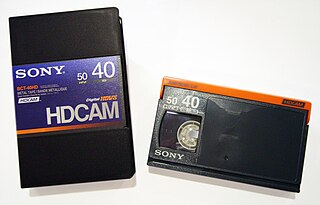
HDCAM is a high-definition video digital recording videocassette version of Digital Betacam introduced in 1997 that uses an 8-bit discrete cosine transform (DCT) compressed 3:1:1 recording, in 1080i-compatible down-sampled resolution of 1440×1080, and adding 24p and 23.976 progressive segmented frame (PsF) modes to later models. The HDCAM codec uses rectangular pixels and as such the recorded 1440×1080 content is upsampled to 1920×1080 on playback. The recorded video bit rate is 144 Mbit/s. Audio is also similar, with four channels of AES3 20-bit, 48 kHz digital audio. Like Betacam, HDCAM tapes were produced in small and large cassette sizes; the small cassette uses the same form factor as the original Betamax. The main competitor to HDCAM was the DVCPRO HD format offered by Panasonic, which uses a similar compression scheme and bit rates ranging from 40 Mbit/s to 100 Mbit/s depending on frame rate.
Progressive segmented Frame is a scheme designed to acquire, store, modify, and distribute progressive scan video using interlaced equipment.
AVCHD is a file-based format for the digital recording and playback of high-definition video. It is H.264 and Dolby AC-3 packaged into the MPEG transport stream, with a set of constraints designed around camcorders.
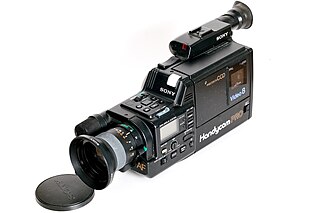
Sony Corporation produces professional, consumer, and prosumer camcorders such as studio and broadcast, digital cinema cameras, camcorders, pan-tilt-zoom and remote cameras.
MOD and TOD are recording formats for use in digital tapeless camcorders. The formats are comparable to XDCAM EX, HDV and AVCHD.
A digital movie camera for digital cinematography is a motion picture camera that captures footage digitally rather than physical film, which shoots on film stock. Different digital movie cameras output a variety of different acquisition formats. Cameras designed for domestic use have also been used for low-budget independent productions.
The Apple Intermediate Codec is a high-quality 8-bit 4:2:0 video codec used mainly as a less processor-intensive way of working with long-GOP MPEG-2 footage such as HDV. It is recommended for use with all HD workflows in Final Cut Express, iMovie, and until Final Cut Pro version 5. The Apple Intermediate Codec abbreviated AIC is designed by Apple Inc. to be an intermediate format in an HDV and AVCHD workflow. It features high performance and quality, being less processor intensive to work with than other editing formats. Unlike native MPEG-2 based HDV - and similar to the standard-definition DV codec - the Apple Intermediate Codec does not use temporal compression, enabling every frame to be decoded immediately without decoding other frames. As a result of this, the Apple Intermediate Codec takes three to four times more space than HDV.
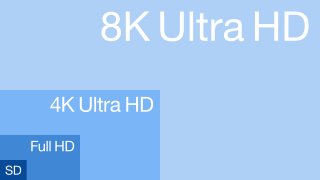
8K resolution refers to an image or display resolution with a width of approximately 8,000 pixels. 8K UHD is the highest resolution defined in the Rec. 2020 (UHDTV) standard.

The Canon PowerShot S95 is a high-end 10.0-megapixel compact digital camera announced and released in 2010. It was designed as the successor to the Canon PowerShot S90 in the S series of the Canon PowerShot line of cameras.
A 3D camcorder can record 3D video.
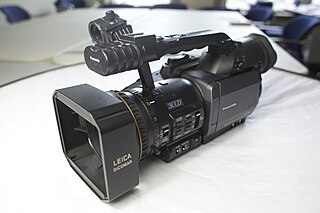
The Panasonic AG-DVX100 was a video camera that released in October 2002. Its 60Hz version was the first consumer-affordable digital camcorder capable of recording video at 24 progressive frames per second.
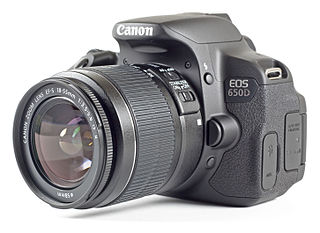
The Canon EOS 650D, known as the Kiss X6i in Japan or the Rebel T4i in America, is an 18.0 megapixels digital single-lens reflex camera (DSLR), announced by Canon on 8 June 2012. It is the successor of the EOS 600D/Kiss X5/Rebel T3i and is the predecessor of the EOS 700D/Kiss X7i/Rebel T5i. Sales began on 15 June 2012. At introduction, recommended retail prices for the body were US$849.99, £699.99, and €839.99.











